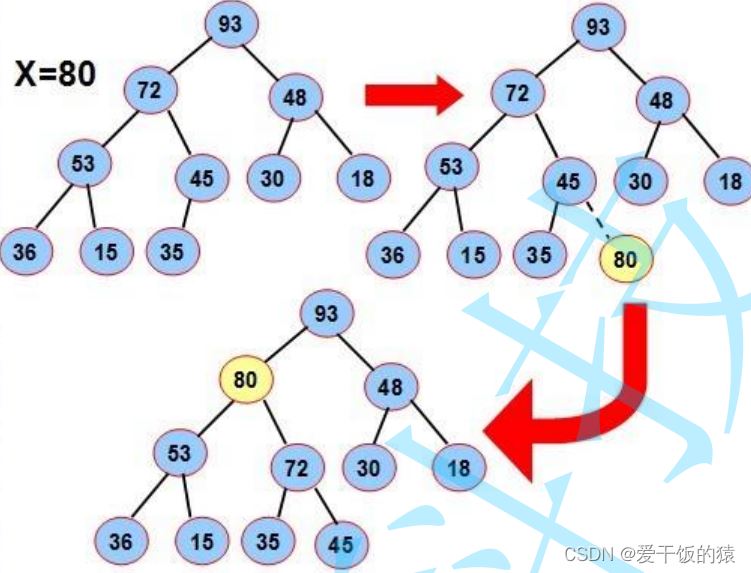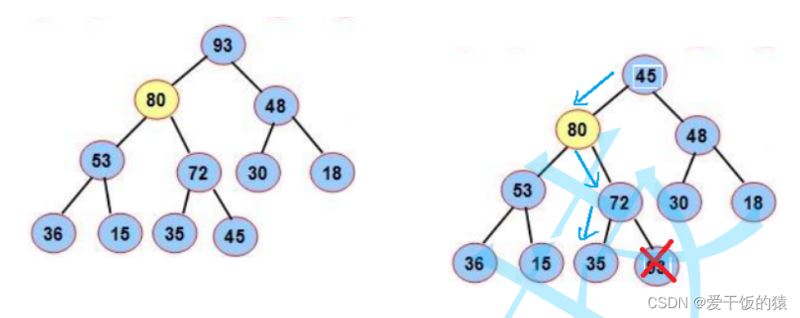Java 堆 优先级队列
爱干饭的猿 人气:01.优先级队列
1.1 概念
在很多应用中,我们通常需要按照优先级情况对待处理对象进行处理,比如首先处理优先级最高的对象,然后处理次高的对象。最简单的一个例子就是,在手机上玩游戏的时候,如果有来电,那么系统应该优先处理打进来的电话。在这种情况下,我们的数据结构应该提供两个最基本的操作,一个是返回最高优先级对象,一个是添加新的对象。这种数据结构就是优先级队列(Priority Queue)。
1.2 内部原理
优先级队列的实现方式有很多,但最常见的是使用堆来构建。
1.3 操作-入队列
过程(以大堆为例):
1. 首先按尾插方式放入数组
2. 比较其和其双亲的值的大小,如果双亲的值大,则满足堆的性质,插入结束
3. 否则,交换其和双亲位置的值,重新进行 2 、 3 步骤
4. 直到根结点
图示:

1.4 操作-出队列(优先级最高)
为了防止破坏堆的结构,删除时并不是直接将堆顶元素删除,而是用数组的最后一个元素替换堆顶元素,然后通过向下调整方式重新调整成堆

1.5 借用堆实现优先级队列
1.实现一个接口
public interface IQueue<E> {
// 入队
void offer(E val);
//出队
E poll();
//返回队首元素
E peek();
//判断队列是否为空
boolean isEmpty();
}
2.堆完整代码见Java堆&优先级队列示例讲解(上)
3.优先级队列
/**
* 基于最大堆的优先级队列,值越大优先级越高
* 队首元素就是优先级最大的元素(值最大)
*/
import stack_queue.queue.IQueue;
public class PriorityQueue implements IQueue<Integer> {
MaxHeap heap = new MaxHeap();
public PriorityQueue(){
heap = new MaxHeap();
}
@Override
public void offer(Integer val) {
heap.add(val);
}
@Override
public Integer poll() {
return heap.extractMax();
}
@Override
public Integer peek() {
return heap.peekMax();
}
@Override
public boolean isEmpty() {
return heap.isEmpty();
}
}
1.6 测试
import java.util.Comparator;
import java.util.PriorityQueue;
import java.util.Queue;
public class PriorityQueueTest {
public static void main(String[] args) {
// 通过构造方法传入比较器
// 默认是最小堆,"值"(比较器compare的返回值)越小,优先级就越高
// 当传入一个降序的比较器时,值(比较器compare的返回值,值越大,返回负数)
// Queue<Student> queue = new PriorityQueue<>(new StudentComDesc());
// Queue<Student> queue = new PriorityQueue<>(new Comparator<Student>() {
// @Override
// public int compare(Student o1, Student o2) {
// return o2.getAge() - o1.getAge();
// }
// });
Queue<Student> queue = new PriorityQueue<>(new StudentCom());
Student stu1 = new Student(18,"雷昊");
Student stu2 = new Student(20,"张超");
Student stu3 = new Student(16,"钺浦");
queue.offer(stu1);
queue.offer(stu2);
queue.offer(stu3);
while (!queue.isEmpty()){
System.out.println(queue.poll());
}
}
}
//升序(最小堆)
class StudentCom implements Comparator<Student> {
@Override
public int compare(Student o1, Student o2) {
return o1.getAge() - o2.getAge();
}
}
//降序(最大堆)
class StudentComDesc implements Comparator<Student> {
@Override
public int compare(Student o1, Student o2) {
return o2.getAge() - o1.getAge();
}
}
class Student{
private int age;
private String name;
public int getAge() {
return age;
}
public Student(int age, String name) {
this.age = age;
this.name = name;
}
@Override
public String toString() {
return "Student{" +
"age=" + age +
", name='" + name + '\'' +
'}';
}
}
结果如下:Java堆&优先级队列示例讲解(上)

加载全部内容